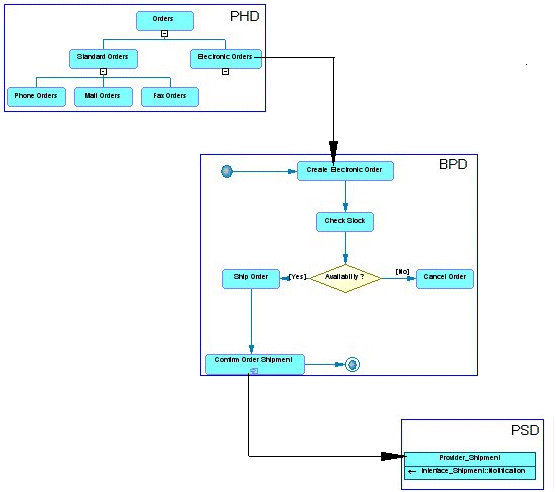A business process model (BPM) helps you identify, describe, and decompose business processes. You can analyze your system at various levels of detail, and focus alternatively on control flow (the sequence of execution) or data flow (the exchange of data). You can use BPEL, BPMN, and many other process languages.
Business process modeling is a set of technologies and standards for the analysis, design, implementation and execution of business processes. It enables business analysts and managers to analyze a system in order to rationalize and optimize it or to model a new system.
Business process languages are organized in three types:
-
Analysis languages — to describe the organization of a system without any implementation details.
-
Orchestration (or execution) languages — to describe the implementation of business processes as Web services or applications and define how they can be connected to accomplish specific tasks.
-
Collaborative languages — to describe the choreography of business documents in a binary or multi-party collaboration.
For information about these languages, see BPM process languages.
The PowerDesigner® BPM provides the following diagrams:
|
Diagram |
Icon |
Description |
|---|---|---|
|
Process hierarchy diagram |

|
A high-level diagram, which analyzes your business functions as a hierarchy of processes (see Process hierarchy diagram). |
|
Business process diagram |

|
Analyzes the control flow of a process at any level of the process hierarchy (see Business process diagram). |
|
Process service diagram |

|
Displays your service providers and any dependencies between them (see Process service diagram). |
The picture below shows how the BPM diagrams can interact within your model. The process hierarchy diagram (PHD) displays the processes of your system in a hierarchy. Each of these processes can be analyzed in its own business process diagram (BPD). Service providers (often web services) used to implement the sub-processes can be displayed in a process service diagram (PSD):

Suggested Bibliography
-
The Workflow reference Model - http://www.wfmc.org.
-
Business Process Model Language Specification - http://www.bpmi.org/.
-
Document: Business Process Specification Schema - http://www.ebxml.org/.
-
Alan Kotok, David R. Webber, David RR Webber - ebXML: The New Global Standard for Doing Business on the Internet - New Riders Publishing, 2001.
-
Business Process Execution Language for Web Services Specification – http://www.ibm.com/developerworks/library/specification/ws-bpel/.